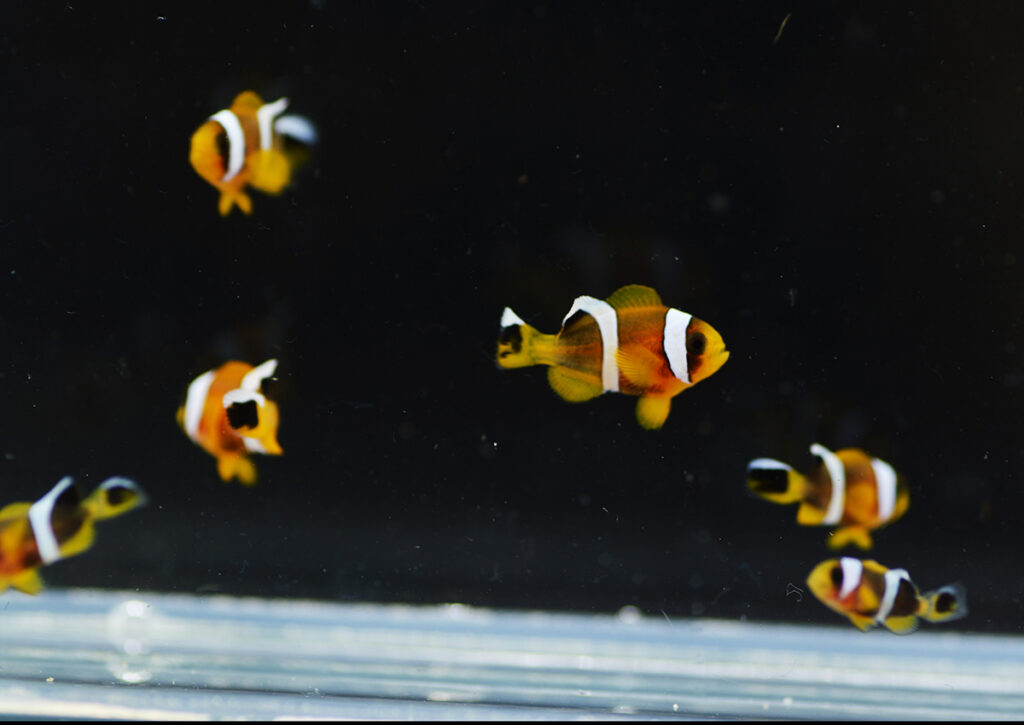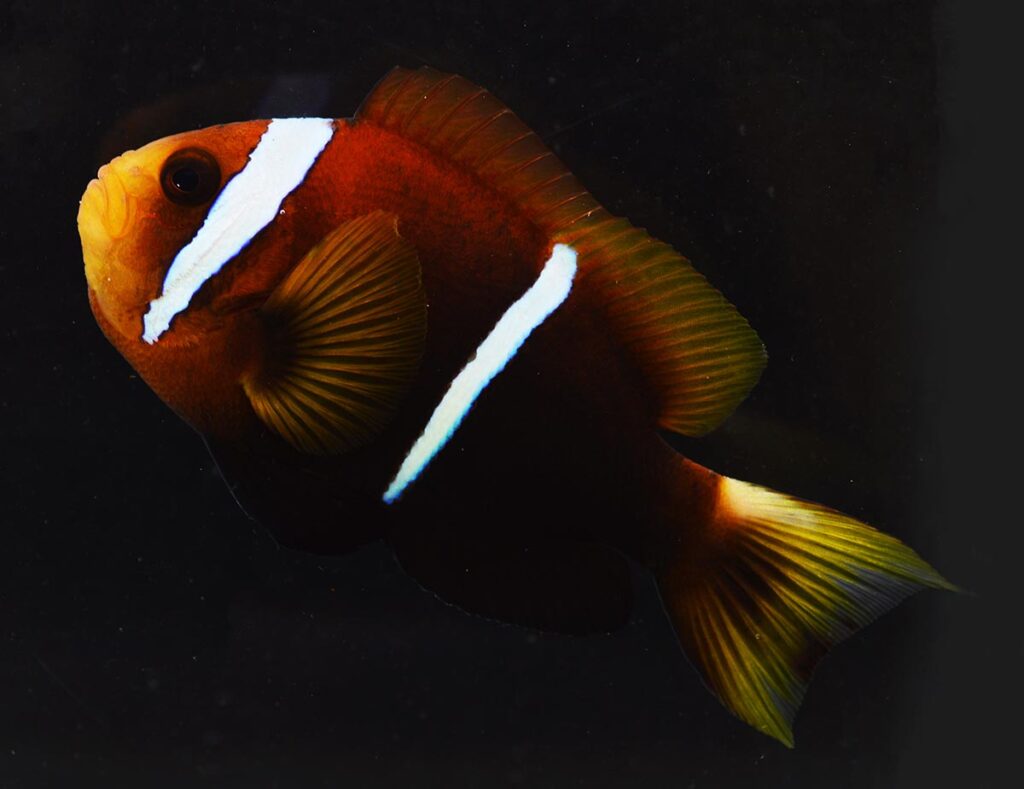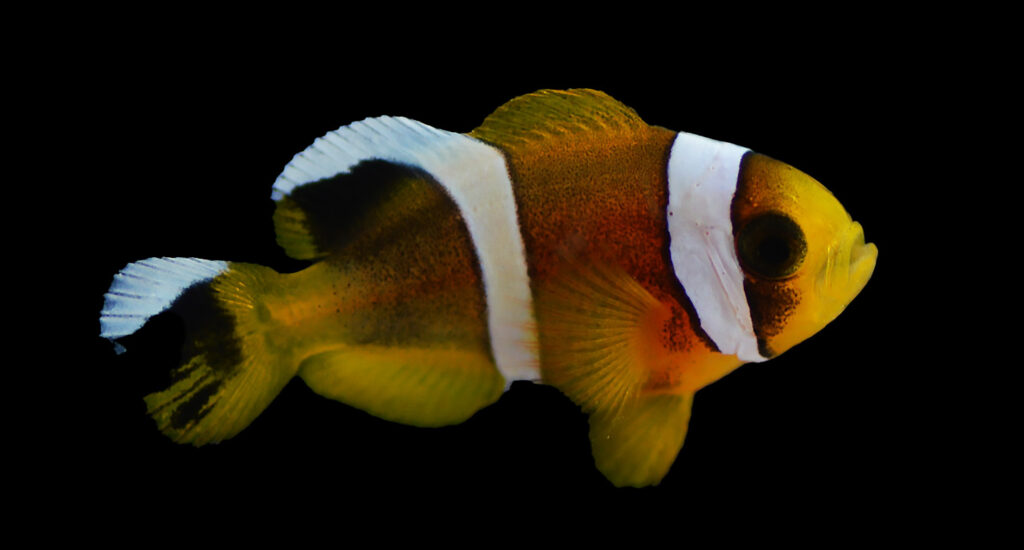
Clownfishes/Anemonefishes of the genus Amphiprion are a captive-breeding staple in the marine ornamental aquaculture world. Of the currently 30 recognized clownfish species, 25 have been bred in captivity. While not every species is the “guppy” of the marine aquarium world, and several species present some difficulties in culture, clownfishes remain a steadfast gateway to the world of marine fish breeding at home.
Those 5 anemonefish species that have yet to be bred? For the marine fish breeder looking to claim a “species first”, they represent a peculiar challenge. These 5 species are alluring candidates to breed a fish that has never been bred before, but the difficulties start with simply getting the fish in the first place, and three of these species have long fallen on the list of fish that may in fact be illegal to obtain, residing entirely in protected, no-take areas! However, the recent, brief exportation of the Oman Clownfish, Amphiprion omanensis, paved the way for one of the elusive, increasingly rare opportunities to breed a clownfish species for the first time. This week, Tom Verhoeven at De Jong Marinelife in Spijk, Gelderland, Netherlands, has claimed victory in this exclusive race. – Matt Pedersen

by Tom Verhoeven, via De Jong Marinelife
BREAKING NEWS: Tank-Bred Amphiprion omanensis.
Last year (2022) we announced the arrival of some of the rarest fish in the industry; Amphiprion omanensis. This ultra-rare clownfish has a limited natural distribution from the eastern Indian Ocean only along the coast of the Sultanate of Oman. The Oman Clownfish has a chocolatey brown body that is bisected by two thin white bars, but the colors of the fins span the spectrum found in the anemonefish; the pectoral fins are golden yellow-orange, the pelvic and anal fins are dark black, and the large lyre-shaped tail is a pearly white.
Our breeding pairs were quarantined and transferred to our broodstock department. It became clear the specimens were not completely grown. In the first months they almost doubled in size. In the last months, we saw different signs spawning was imminent. From this point, an intensive conditioning process started. Salinity was adjusted, the temperature was raised, a symbiotic anemone was added, and feeding was increased to a maximum. The pairs were cleaning their shelter for weeks, females’ abdomens became swollen, and finally, we were rewarded with a nice clutch of orange/yellow eggs from one of the pairs.
The eggs were taken away prior to hatching and transferred to our laboratory for examination. They passed a health check, and later that night more than 1,000 larvae hatched. The larvae show great similarities with the larvae of the Red Sea or Two-banded Clownfish, Amphiprion bicinctus. They were fed with all kinds of live foods including enriched rotifers, Artemia nauplii, copepods, and cry[sic] plankton. After 10 days metamorphosis began. After 15 days of living in a black round larval tub with greenwater, metamorphosis was complete, resulting in exciting, tiny juvenile Oman Clownfish.

The offspring are one of the most captivating clownfish you will ever see, not only because of their beautiful coloration; their unique swimming behavior makes them very interesting to observe. The juveniles are completely different than their parents. They are more yellow/ orange with nice black markings on their fins.

Compared to other “bigger” clownfish species the Oman clownfish is not that aggressive. This makes this species an ideal candidate for reef aquariums. It’s almost surreal how one of the rarest fish species can become a common, affordable, species due to our breeding efforts. This story is exactly why we set up our hatchery. Captive-bred Oman Clownfish will soon be available for everyone.
I must offer a big shout out to my entire team of breeders at the De Jong Marinelife Fish Nursery who make this happen; Marloes, Eva, David, Jesus, Jaimy, Maarten, Jimmy, Dieuwertje, Marit, Chiel, thank you! And of course, Arie de Jong, who makes it happen and allows us to pursue exciting new marine ornamental aquaculture projects beyond the commercially-popular and common species!
###





Hi Matt,
I always read with great interest your articles on any new species being bred and especially the loves of my fish life, the Clownfish. (I was the first Clownfish breeder in Canada back in the late 80’s, having reared 9 varieties from a basement operation and have spoken at MACNA twice and given over 75 presentations, on maintaining marine tanks and rearing Clownfish, in all the four corners of Canada and the US. My goal was to try and raise as many different varieties as possible to avoid taking any more off the reefs.
Your article on the first raising of the Oman Clownfish struck a particular chord with me. At the MACNA XXVI held in Denver Colorado, Colorado August 29-31, 2014, we took the opportunity to visit the Denver Aquarium and I was stunned to see a pair of Oman Clownfish on display because everything I had heard was that collection and exporting from Oman was prohibited.
Here is one of the pictures we took:
I had a particular fascination with this species of Clownfish because they develop a more pronounced forked caudal fin as they mature, even more than some “clarkii”.
I tried to speak to someone at the Denver Aquarium about if they had tried or had any plans to try to breed them and unfortunately no one at the Aquarium that day knew anything about them and even what type of Clownfish they were. All they did know was that an anonymous donor had given the pair to the Aquarium. I even wrote to them to offer any assistance but I never got a reply.
So, all these years, I am truly pleased to hear that another species will be reared in captivity, this again is of particular interest because I am preparing to give a talk (which I have given a few times since 2014), entitled “ANEMONE FISHES OF THE WORLD”. I confirmed my last update in communication with Dr. Gerry Allen, (we spoke together at a MACNA), when he discovered the Amphiprion Pacificus.
In this talk. besides the ones that I raised personally, I also identify the species that have been raised by different breeders and facilities. Previously you used to issue a list of Marine fish that had been raised in captivity, but since 2019 I have not been able to find an updated version which now of course would include the Oman Clownfish.
Can you tell me if such a new list exists and I would like to see which species of Clownfish that have still not been reared.
Thanks Robert Di Marco